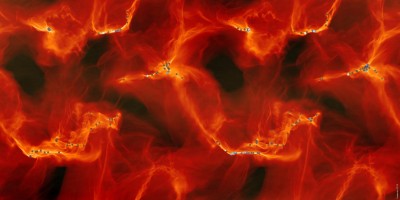11 April 2014
An international team of astronomers has developed a novel technique to reconstruct an interstellar cloud’s three-dimensional structure, to estimate how many new stars the cloud is likely to form.
The results, published today in the journal, Science, mean that current theories of star formation can now be accurately tested.
Led by astronomers from the Max Planck Institute for Astronomy in Heidelberg, Germany, and Monash University, the team developed simplified models and numerical simulations of three-dimensional structures of molecular clouds, and compared them to images of real gas and dust clouds in the Milky Way.
Previous observations were limited to information contained in two-dimensional structure of clouds. This new technique allowed the team to partially reconstruct the actual three-dimensional structure of interstellar clouds. The technique means that for the first time astronomers will be able to directly test star formation theories.
The team used data from an astronomical version of a medical X-raying procedure to predict the rate at which a molecular cloud – a stellar nursery – forms new stars.
Stars form within giant clouds of interstellar gas and dust, shaping the structure and determining the evolution of entire galaxies. Born when a dense region within a molecular cloud collapses under its own gravity, the region contracts until the pressure and the temperature inside are high enough for nuclear fusion to set in, signalling the birth of a new star.
Dr Christoph Federrath from Monash University, who provided numerical simulations to test the new technique, said it could potentially tackle one of the greatest unanswered questions of astrophysics.
“We finally have the tools to take a picture of a cloud and predict how many stars we can expect the cloud to form.” Dr Federrath said.
Focusing on clouds within a distance of 1500 light years from Earth, the team compared their reconstruction with direct observations of how many new stars had recently formed in these clouds. In this way, they were able to identify a "critical density" of 5000 hydrogen molecules per cubic centimetre, and showed that only regions exceeding this critical density can collapse to form stars.
Dr Jouni Kainulainen from the Max Planck Institute for Astronomy said this marks the first time anyone has determined a critical density for forming stars from observations of cloud structure.
“Theories of star formation have long predicted the importance of such a critical density. But our reconstruction technique is the first to allow astronomers to deduce the density structure of these clouds – and to confront star formation theories with observational data.
"We've handed astronomers a potent new tool. Star formation is one of the most fundamental processes in astronomy – and our results allow astronomers to determine star formation rates for more clouds than ever before, both within our own galaxy and in distant other galaxies,” Dr Kainulainen said.
Dr Thomas Henning, Director at the Max Planck Institute for Astronomy and co-author of the study, said the new model is a game changer for people working in astronomy.
“With our technique, we're able to say: show us your data, and we will tell you how many stars your cloud is forming right now,” said Thomas Henning.
The discovery will inform ongoing work to estimate the number and mass of stars that will form in more distant molecular clouds, potentially resulting in a map of star births within our home galaxy.

Recipe for star formation discovered

Computer simulation of a star formation in a turbulent gas cloud. Copyright: Christoph Federrath











